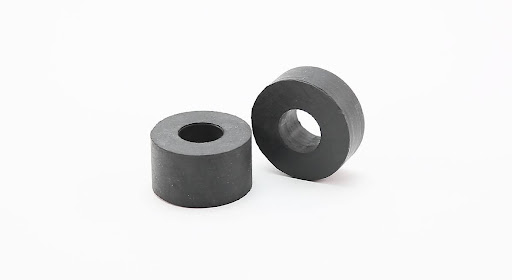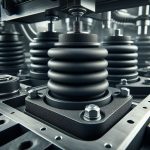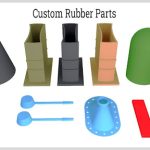The rubber form of energy dissipator, which is a central component of vehicle design manufacture along with shock absorbers, is installed to improve vehicle performance both for the sake of comfort, but also road safety.
During their design, the shock absorbers may be configured in different positions which allows engineers to use them as supplementary tools in the process of vehicle manufacturing.
Similarly, they are significant even though in most cases they get ignored by the publicity. This write-up, which is to identify, explain, and elaborate on the types, advantages, sources of challenges, and ultimate future outlook for such bushes, is our goal of making you aware of this whole topic.
Via the course of this writing, rubber bushes are explored thoroughly ensuring their critical role in the automobile, especially focusing on such aspects as suspension that not only make the car stable but also vibration-free thus, providing a car passenger with a peaceful ride feeling.
Introduction to Rubber Bushes
The rubber bushes, and as you already know, the bushes also referred to as rubber mounts or suspension bushes, make up the fundamental part of a vehicle suspension system.
Their most important obligation is to be air shock absorbers, noise attenuators and vibration dampers so that working arms can rest on chassis belts.
Through the action of reducing friction and being made to avoid the direct impact of metal parts against one another, rubber bushes are known for their significant contribution to the overall performance and survival of different vehicle components.
Table of Contents
Shock Absorption and Impact in Automotive Engineering
Concerning mechanics in automotive engineering, the non-negligibility of shock absorption confirms. It is an important part of the technology with the aim of reducing road unpleasantness such as bumps and a coarse road by providing passengers with an optimal smooth and harmonious ride.
Besides this, such meaningful shock absorption is not only confined to comfort; it also has the effect to reduce damages which might occur to essential vehicle components as a result of excessive wear and tear, and this maximizes their operational period.
Fleeting of all, this feature is not only one of the most important for driving performance but also serves to maintain vehicle stability, handling, and safety, being thus the fundamental aspect of automotive design and engineering.
Types of Rubber Bushes
Standard Rubber Bushes
There is more and more likelihood that the bushes of rubber standard tires are made from natural or synthetic rubber materials. They are known as flexible, cheap, and impact attenuation devices to moderate extents. They are globally used. Additionally, it has an infirmity that they can easily get exhausted by them from a faster wear and tear than the other types of rubber bushes.

Polyurethane Bushes
The polyurethane bush is the key among all as they are very stiff and long-lasting compared to normal rubber bush. They are resistant to oil, chemicals and abrasion even if they belong to the extreme applications. Although polyurethane bushes provide improved steering feel and sharpness, they may ride up the car faster to the passengers ears due their stiffness and reduced vibrations.
Silicone Bushes
Rubber silicone bushes really impress with their heat resistivity and flexibility, so they are preferable for high performed cars. On top of this, they are known to be the best in heat resistance and for surviving tough surroundings. Moreover, silicone bushes accomplish better damping jobs besides other rubber bushes especially, they are less likely to deteriorate over time.
How Rubber Bushes Work
Rubber bushes incorporate at absorbing the kinetic energy while the vehicles move. The rubber material undergoes compression during quick-changing directions and metal impacts, absorbing the energy. This mechanism blocks the escape of extra energy from the vehicle components except the wheel, therefore making the drive more smooth as well as stable.
Advantages of Using Rubber Bushes
Enhanced Passenger Comfort
Especially engineered rubber bushes are much more capable of reducing oscillations and noise, making a more comfortable and quiet ride for travelers.
Protection Against Wear and Tear
They have the function to be a protective shield that prevents this type of damage to the suspension element which causes their early wear and results in its early end of life.
Improved Vehicle Stability
Importantly, rubber bushes for suspension not only allow such vehicle’s reaction to uneven road surfaces but ensures better stability, handling, and maneuverability.
Reduced Noise Transmission
Sound insulation provided by bushes helps for the quieter cabin space to enjoy the air conditioning and the radio on the way.
Cost-Effectiveness
Rubber bugs have proved to solve suspension problems at low cost, tending to be the balance between performance and expense compared to other alternatives.
Upgrade Your Ride Today with High-Quality Rubber Bushes!
Challenges and Considerations
The rubber bushes have great potential; however, also, they possess certain challenges. Factors, among them environmental elements including heat, humidity and chemicals, are possible to dish-out damages over the long-term period. It is imperative to carry out regular inspections and maintenance so that the unit remains at an excellent level of functioning as well as durability. Beyond that the correct choice of rubber bushes type adjusted to specific needs of each vehicle and driving conditions recognition improves the effectiveness of their work.
The improvements that were encountered in Armoring Technology Rubber Bush
Focusing on increasing durability as well as performance of rubber bush is the innovation of the latest rubber bush technology. In addition to that, the sustainable factor has not been forgotten. Manufacturer’s identification of materials like hybrid, polymer based systems and elastomers revolutionize the market since they make bushes more resilient and eco friendly. And in order to bring forward an even higher level of efficacy with respect to dimensional accuracy and reducing the quantity of sound emitted, advancing engineering precision techniques are being utilized, upgrading the level of pride.
Applications in Automotive Engineering
Bushes from rubber are quite versatile and can be used in not only suspension systems (i.e. dampers, springs, struts), but also in engine compartment (mounts), steering assemblies, transmission mounts, and anti-roll bar links. The significance of these shock absorbers in current cars stem from their adaptability and high efficiency. They are essential components that aid in improving the ride quality and safety thus, and contribute greatly to vehicle performance.
Maintenance and Care Tips
To ensure the longevity and optimal performance of rubber bushes, adhere to these maintenance tips:To ensure the longevity and optimal performance of rubber bushes, adhere to these maintenance tips:
- Take time and inspect rubber bushes very often in search of wear, damage or bad softening.
- Ensure the cleaning of suspension components remains clear and free from particles associated with excess wear;
- Use lubricants, as per the manufacturer’s specification, to keep bushings in optimum state to avoid jamming.
- Eradicate premature wearing or damage of rubber bushes by early replacement to avoid safety implications and other damages.
- Perform the maintenance as per the prescribed manufacturer’s scheduled maintenance instructions and guidelines to cater overall maintenance.
FAQs
The replacement interval depends on various factors such as vehicle usage, road conditions, and maintenance practices. It’s recommended to inspect rubber bushes during regular servicing and replace them if signs of wear or damage are observed.
Yes, lubrication can help reduce friction and extend the lifespan of rubber bushes. Use silicone-based lubricants recommended by the manufacturer and apply them sparingly to avoid attracting dirt and debris.
Polyurethane bushes offer advantages in terms of durability and stiffness, making them suitable for high-performance applications. However, their firmer nature may transmit more vibrations to the vehicle cabin compared to standard rubber bushes.
Signs of worn-out rubber bushes include excessive noise or vibration, uneven tire wear, loose steering, and reduced ride comfort. It’s essential to address these symptoms promptly to prevent further damage to the suspension system.
While some DIY enthusiasts may attempt to replace rubber bushes, it’s generally recommended to have this task performed by a qualified mechanic or automotive technician. Proper tools, equipment, and expertise are necessary to ensure safe and effective bushing replacement.



